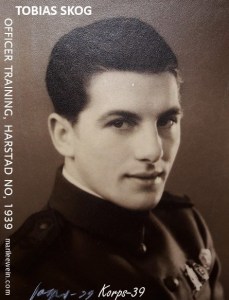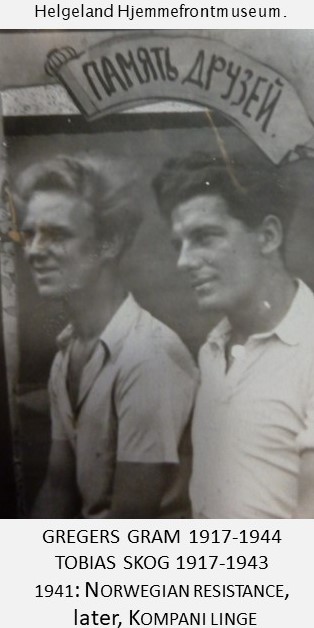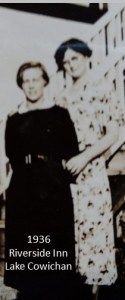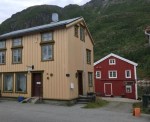My grandparents, Johan and Johanna Skog, were laid to rest without knowing the place or date of their son’s death. My mother, Anne, laid down flowers …
Torill Vang Amdam, niece of Tobias Skog


10 Feb 1943: Fenrik (Second Lieutenant) Tobias Skog was second in command to a group of six saboteurs from the Kompani Linge organization. They were aboard submarine Uredd when she sank upon hitting a minefield off the coast of Norway. Shy of 26, he was full of achievement. We will tell his war stories, civilian too, and try to get a sense of his unlived potential.
Today, 8 May, is , Liberation Day in Norway. We are weeks away from our Memorial Day to honor war dead. The tiny moment that some of us will care to spare in remembrance, must stretch to appreciate the whole of the sacrifice behind the loss of a uniform.

Family memo: Tobias was Anna’s nephew and she was great-uncle Ed Hemmingsen’s formidable wife. All were from Vefsn, Norway.
In 1926, Anna and Ed had just relocated to Lake Cowichan, B.C., after decades of US-domicile and naturalized citizenship. Their George was US-born. Close family in the US and Canada mourned Tobias, along with those in Norway.
Coincidentally in 1926, Anna’s sister, Johanna, arrived from Mosjøen, Vefsn with their great-niece. The child, whom we had aliased the Baroness of Skog-Vefsn, would become Ed and Anna’s adopted daughter, Betty.
Johanna had to leave her two small children at home in Norway with Johan, for the duration of her long round trip: Anne, whose own daughter is our dear informant, and Tobias, commando and hero of WW II.
1938: OFFICER TRAINING: HARSTAD NORWAY
Corporal Skog, 22 in the 1939 photo above, went to Officer Training at Harstad prepared to assume serious responsibility. He was an athlete; a local football player and a long distance runner. His friends and he were involved in volunteer work, and he was very much, involved with his family. He took a business curriculum in college.


Tobias’ varied pursuits resulted in a skill set that combined patience, agility, strength and stamina with a keen ability to focus and strategize.
He died aboard the Uredd aka unafraid, fearless. Courage was the attribute he would come to rely upon, for what happened next.
1940: BATTLES OF NARVIK, NORWAY
… asked if I knew that uncle Tobias Skog had been fighting against the Germans at the front in Narvik in 1940.1 At that time, Tobias Skog was a corporal. He and others from the officers’ school in Harstad were sent to the front. They fought well.
His bataljen nr 6 was fighting near Narvik in 1940 and later Tobias was sent to Bodø with others to protect the airport against the Nazi bombing.
Torill Vang Amdam
1941: BRITISH SPECIAL OPERATION EXECUTIVE GROUP and KOMPANI LINGE
The British SOE was working with Norwegian resistance by summer of 1940. They formed Norwegian Company No. 1 in March 1941, destining its members for special commando training in Great Britain. The name Kompani Linge, was taken later, in honor of establishing member, Martin Jensen Linge, who fell in combat that December.
Their mission was to conduct raids and disable key Nazi-controlled Norwegian industry. Their most well-known venture was sabotage of the Rjukan power station in Telemark. It denied Axis access to the heavy water they needed to develop the nuclear bomb.
All told, 530 Norwegians served wartime Kompani Linge. They either worked solo or in small teams. Very few of them came with the military background had by Tobias Skog.2 His SOE/Linge team of six was known as Operation Seagull. (See Notes and Sources, Item 3, for list of members, and note on Uredd casualties)
1941: RESISTANCE FIGHTER TOBIAS SKOG ESCAPES
In early spring 1941, he had to leave our country. A German officer had pointed at him with a gun. Tobias was exposed.
Torill Vang Amdam
EN REISE JORDEN RUNDT FOR FRIHETENS SAK
Tobias Skog, now a high value target, fled to Sweden. He then embarked on an evasive back route to Great Britain, for that special training. Thus, is this memorable record of events that preceded his U-boat tragedy.
Those on the run do not write assurances home, in fear their dear ones would be endangered by enemy monitoring the mail, before its delivery to doorstep. It was not until September 1945, that Tobias’ closest friend, Knut Rogne could write the article below.4 Some of it was adjusted decades later and revision is still possible. Time also revealed others who had fled through similar routes, to fight and die another day, so dear the cost of this war.

A JOURNEY AROUND THE WORLD FOR FREEDOM’S SAKE
Tobias Skog was one of many who traveled to participate in Norway’s liberation struggle.
He left for Sweden in March 1941. His comrades have now succeeded in obtaining more detailed information about his journey.
He was employed by the Norwegian Legion for four months. Then he traveled to England on a journey that took a half year.
He traveled through Russia and the Caspian Sea, twice. He went across the Black Sea to Iran. Then he went to India, staying in Bombay for two months.
Tobias Skog was also in China and was one of the few who crossed over the Himalayas. The journey continued to Africa and from there to South America, Canada and finally to England.
He was enrolled in the Norwegian departments, enlisted in Norwegian Independent Company No. 1. [Kompani Linge]. He participated in a number of cruises and received several awards, including being decorated with a Haakon VII medal [recognizes service in Norwegian armed forces in Britain].
Tobias Skog was an avid and skilled sportsman and gymnast. He was a member of Mosjøen A.I. L. [a local sports team in the Helgeland District of the Norwegian Worker’s Sport Federation]. In 1938 he became North Norwegian champion in races. He had a number of sports awards.
In 1943, Tobias Skog was with U-boat Uredd who was on a trip to the Norwegian coast for operations. The submarine disappeared on 28 February. There were no survivors to tell about the tragedy.
En reise jorden rundt for frihetens sak, by Knut Rogne. Translate.com: A journey around the world for freedom sake. Published September 1945, by Helgeland Arbeiderblad
PASSPORT and TRANSIT VISAS
As Rogne noted, Tobias stopped in Sweden, in a four-month duty with the Norwegian Legion. He used that time to renew his passport and stack it with visa for the numerous continents and countries, consistent with the travelogue. – Or, the military did, pre-planning his scurry; perchance, with a second agenda. Imagine this mobile talent, otherwise in limbo, in this personnel-starved resistance. We shall not know what else may have been going on.
Tobias’ ready passport was stamped on June 25 by the Exchange Agent of the travel agent Wagons-lit Cook, in Stockholm. A few of his transit visa are shown here.


Tobias had company in Gregers Gram for some part of his journey. They are pictured left in a photo held at the Helgeland Hjemmefrontmuseum.1 Gregers’ travel was also posthumously gathered. The places mentioned both differ and converge, without enough information to assess overall overlap.
The decorated Gram was namesake grandson of a Norwegian Prime Minister. He was shot by the Gestapo in 1944 during a café escapade where he was sent to mislead them with propaganda.
VISA: VALID FOR DIRECT TRANSIT ONLY TO CANADA
It is hard to tell if some visas were requested, but not used, especially that for Canada. Passport Officer Wiley was determined to send him there, writing documents 8300 and 8301 in tandem: Valid for direct transit only to Canada (his Palestine visa allowed further transit to Syria). Rogne claimed he visited Canada before England, but doubt came in a report on Gregers Gram.5 It had Gregers’ land in Trinidad, and from there to Glasgow. The two may not have been together and/or Canada may have been overlooked. Whether Tobias went to Canada or not, would not change the Uredd outcome; it mattered to the family.


OUR DOOMED HERO’S WISH
Tobias cherished a picture from 1936, of Anna and Betty on the stairs of Riverside Inn, the family business at Lake Cowichan. His mother had been Betty’s constant caregiver in the Mosjøen home, since her mother had to work. His sister, Anne, reminiscing later to her own children, told that she was six when Betty was born. Tobias was three, and nine when she left. Their bond was tight; he longed to see her.
Even so, not all musings of family table are brought forward to the next generation. Back in the day, quiet family happenings were kept quiet. The greatest generation added to that by keeping their war grief bottled up inside.
The present generation is fascinated by a picture of Tobias, thought of 1941 – that beckons another. That other is of Tobias in the same clothing, but with Betty. It has gone amiss, or, it is a figment of their mind’s eye, conjured by wistful conversation that may have happened long ago.

THE JOURNEY ENDS: DID CANADA HAPPEN?
Rogne specified “South America” but there were no applicable visas in Tobias’ passport. Again, Gram’s account suggested it was Trinidad. That feels right politically, and as a terminus for southern travel after Africa, for a UK destination. While Trinidad to Glasgow was a possibility, better documented was to hug the US coast from Trinidad to Halifax, and then to Great Britain.6
Tobias had a visa for transit through the US, so a trip to the west coast of Canada from South America remains feasible. Except for time constraint, maybe. He had been permitted to land in Bombay, August 18, with much road ahead. A record suggests his overall trip was completed on November 17. Halifax was both likely and his most likely Canada scenario.

Archive of the High Command for this “Norwegian who arrived in Great Britain” was most enlightening. He arrived 17 Nov 1941 from Sweden.7 Word of mouth would have to do.
Lingering intimations of a meeting: fearless Anna loved to travel, whether cross-continent or overseas. In fact, in September 1941, Ed and Anna, each now double expats of US and Norway, crossed the border without passports for a funeral visit.8 No problem to travel, over here. Betty was now 21. Anna would have jumped at the opportunity to take her on that fabulous train trip, starting by boarding the ferry in Victoria, then through the Rockies, past the prairies, Ontario, MAIS OUI! Then, into the Maritimes for joy at Halifax. She would see to it, that her nephew got his wish.
1942: STS 26
Rougthvedt, mentioned STS 26 in connection with Gram, a camp isolated in the Scottish Cairngorms. Great Britain had many secret camps, but this most resembled conditions of Norway. It is the site of major training for Norwegian Independent Company No 1. Tobias would have joined the group late 1941 and we know he was on a mission by February of 1943.
Although the duty was fraught with dreadful risk, it was a beautiful place to be.9 The Nazis were aware of the SOE training efforts for Norway and other nationals, even hyper aware of the effectiveness of their guerrilla and sabotage tactics. To be exposed to them as a member made one subject of Commando Order of 1942: immediate execution; no trial. Relatives and villages came next.
1943: OPERATION SEAGULL: ITS LAST MISSION
As said, the six-man S.O.E. team of Operation Seagull was tasked to cripple Norwegian industrial sites such as at Arendal, that were controlled by, and key to Nazi success.
Their last mission began on 6 Feb 1943, setting forth from Scotland’s most northerly point: Shetland.10 There they joined HNoMS Uredd and its 35-strong crew, plus one commando from another team.

Operation Seagull was to go ashore near Bodø, some 300 km north of Tobias’ home. He had fled his country two years before, wondering if he would ever return. Now his loving heart brimmed to breaking, wanting to touch, to reassure his family as he passed by Mosjøen in his huge warship. Johan, Johanna and Anne, waiting, unaware, so close by in their golden house; their happy red pier, casting peaceful memories of sea.
As they entered Fugløy Fjord, Tobias reflected deeply on his resistance operation at Bodø airport, for its lesson today. He was engaged with all his strengths; his team focusing on strategy to press through evil that festered from Bodø, some 90 km east, through Fauske Municipality, to the Sulitjelma Gruber smelting plant. Theirs was to foul the power supply of this mining facility.
A sole Norwegian submarine would succumb to battle. It was by catastrophic explosion of a mine. Alas for us, it was HNoMS Uredd, in Fugløy Fjord: 10 Feb 1943.
REMEMBERING

Tobias Skog was to turn 26 on the third of March 1943. His English colleagues honored him with a memorial stone which stands in the yard of Dolstad Church in Mosjøen. It reflects the date Uredd was thought to go missing; 28 February. Ten February would later be established, such that another eighteen precious days had been taken.
… a picture from the military ceremony out at the sea just above where Uredd is resting as a war grave. My mother, brother and I are standing on the deck. There were military, priests and civilians from Canada, England and Norway on board, and these nations had an honor parade by doing bypass with their vessels and submarines.
Torill Vang Amdam, niece of Tobias Skog

GRATITUDE
Such was their sacrifice. Let us be grateful this Liberation Day, Norway and our upcoming Memorial Day, US
Notes and Sources
1 Our thanks to Helgeland Hjemmefrontmuseum. They house much of the family holdings such as Tobias’ album. https://www.facebook.com/helgelandhjemmefrontmuseum/
2 Kompani Linge in Store norske leksikon on snl.no. Retrieved April 29, 2021 from https://snl.no/Kompani_Linge
3 Members of Operation Seagull
- Lt. Per Getz
- Second-Lt. Tobias Skog
- Sgt. Thorlief Daniel Grong
- Cpl. Sverre Granlund (also served as a commando during Operation Musketoon)
- Pte. Eivind Dahl Eriksen
- Pte. Hans Rohde Hansen
Uredd Casualties: U-boat.net and Rune Gjeldnes.com indicate of Uredd, 35 crew members were lost and seven commandos of whom six were members of Operation Seagull.
4 Knut Rogne 1919-1996, well-known of Mosjøen .
5 Dødsspillet : en biografi om motstandsmannen Gregers Gram by Bernt Rougthvedt, pg 167.
6 The Shetland ‘Bus’: Transporting Secret Agents Across the North Sea in WW2 by Stephen Wynn regards Kjelstrup
7 https://media.digitalarkivet.no Riksarkivet: Armed Forces, High Command – Norwegians who arrived in Great Britain
8 Ancestry.com: U.S., Border Crossings from Canada to U.S., 1895-1960, 17 Sep 1941. Arrival at Anacortes, Washington: Hemmingsen Ed, Anna, Matt and Margaret.
10 Rune Gjeldnes https://gjeldnes.com/2018/01/06/operation-seagull-memorial/

1913 VEFSN: JOHAN SKOG wed Johanna Karoline. Born Daniels(sen/dtr) of Daniel Tobiassen, she and her siblings changed their surnames to Tobiassen, then to Thompson – creating ancestry havoc. Her niece, Thora, had a son, Lloyd Bailey, who dubbed himself Baron of Skog-Vefsn, in fun for family history. He died in 2006, after leaving a key clue for our story series – CLICK HERE for list.
“Unlived potential” I like that and that is certainly the case here.
LikeLike
I agree, and repeated over and over.
LikeLiked by 1 person
Thank you Marilee, warm hugs and I`m crying.I`m so proud of Tobias and glad to see his story written.
LikeLiked by 1 person
I’m proud of him too, and wished to have stood with family in Dolstad Churchyard today.
LikeLike
A nice fact filled tribute. Thank you for sharing this.
LikeLike
Glad you found it interesting, Jo. Thanks!
LikeLike
Greetings from Tacoma, Washington!
Thank you for documenting such a tragic but well told story. Torill was very pleased. I will keep a copy with my genealogy papers.
Hopefully, some day, we will meet in person.
Carla
>
LikeLike
Love that last comment! Thanks!
LikeLike
What an amazing story you managed to uncover, Marilee. Wishing you a Happy Mother’s Day! ❤
LikeLike
Happy Mother’s Day to you, Anna! Tobias was amazing, and like all the fallen, we must remember.
LikeLiked by 1 person
What a lovely tribute! Tobias sounds like a really special person. This post made me think about many countries involved in WWII.
LikeLike
I agree; so many fought with all their might and so many fell. And when we find these heros making their backway to England through so many countries, we realize how many others helped in the world that was truly on fire.
LikeLike
The stories you have uncovered are fascinating, Marilee. Well worth a second and third reading.
LikeLike
That is a wonderful compliment Anna. I shall cherish it.
LikeLike
Your posts are always moving, even on a re-read, Marilee.
LikeLike
Thank you kindly, Anna. I am looking forward to your post today of “Normalizing Pedophilia” – with a little apprehension, for it will be sobering, accurate, and much needed.
LikeLike